Lawn mowing is the most important yard maintenance chore, and how you mow determines the quality of your lawn. Tips and techniques for cutting grass to keep it looking clean-cut and healthy.
Why it’s Important to Mow Properly
Grass plants have adapted to repeated cuttings however, there are side effects to mowing including:
- A brief stoppage of root growth
- Reduced grass food (carbohydrate) production and storage
- Cut leaves create places for disease-causing organisms to enter
- Temporarily increases water loss from cut leaf ends
- Reduces water absorption by the roots
Improper lawn mowing increases these negative effects, giving weeds, diseases and insects the upper hand.
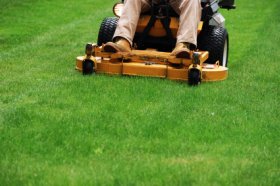
Grass Cutting Rules of a Green-Thumb
These Rules of a Green Thumb will keep your grass looking good, healthy, vigorous, tolerating drought and prepared to fight pest invasions.
- Mow high (2 to 4 inches)
- Mow frequently…before it gets too tall
- Don’t remove more than 1/3 of growth
- Keep your mower blades sharp
- Don’t bag your clippings – “grasscycling” (mulching)
- Don’t cut in the same direction every time
- Blow clippings off walks, driveways, and streets back onto lawns
Mowing Tip #1 – Cut High (2 to 4 inches)
Most lawns should be mowed in the range between 2 to 4 inches – depending on the grass type. Warm-season grasses – Bermudagrass, Zoysia and centipede grass should be mowed shorter 1-2½”.
Creeping bentgrass – a cool season grass – is mainly used on golf course greens and tees. It is occasionally used as a home lawn grass and does best when cut short – ¼ to ¾ inches.
Cool-Season Grasses
- Tall fescue 2 ½ to 3 ½ in.
- Turf-type tall fescue 2 to 3 in.
- Fine fescue 2 ½ – 4 ½
- Perennial Ryegrass 2 to 3 in.
- Kentucky bluegrass 2 – 3 ½ in.
- Creeping Bentgrass ¼ – ¾ in.
Warm-Season Grasses
- Bahiagrass 2 ½ – 4 in.
- Bermudagrass ½ – 1 in.
- Buffalograss 1 ½ – 3 in.
- Carpetgrass 1 – 2 in.
- Centipedegrass 1-2 in.
- St. Augustinegrass 2 – 3 ½ in.
- Zoysiagrass 1 – 2 in.
Cutting grass too short results in…
- Reduced vigor
- Fewer roots
- More frequent cuttings
- Will require more water and fertilizers
- More weeds
- Less resistant to diseases and insect attacks
Taller grass plants…
- Root deeper and tolerate drought better
- Cool the soil and reduce evaporation
- Shade weed seeds from the sun so they don’t germinate
- Produce more carbohydrates (plant food)
Summer Lawn Mowing Tips: If you are growing cool-season grasses, it is a good idea to raise the height of the cut during the heat of the summer. Cutting warm-season grasses low in the summer will improve quality. Prepare them for winter by raising the height in the fall.
Lawn Mowing Tip #2 – Cut Frequently
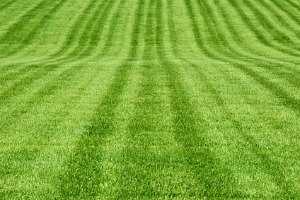
Cut your lawn frequently…before it gets too long.
Proper lawn mowing removes no more than 1/3 of the total length of the leaf blade.
The 1/3 Rule: Cut your lawn often enough so no more than 1/3 of the grass height is removed at any single cutting. For example, If your mowing height is 2 inches – mow the grass when it is 3 inches tall.
You may have to mow every three to four days during the spring/early summer when the grass is actively growing. But only once every seven to 10 days when growth is slowed by heat, drought or cold.
Warm-season grasses – such as zoysia or Bermuda grass – should be cut at lower heights. The more frequently you mow lawns that are maintained short the nicer they will look.
Bentgrass is a cool-season grass that is commonly used on golf greens. It is sometimes used as a home lawn grass. Bentgrass makes a very attractive lawn when mowed short and frequently. It gets ratty and puffy when mowed high.
Mowing Tip #3 – Keep Your Blades Sharp
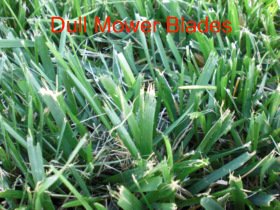
Sharp blades give your lawn a clean, manicured look.
Dull blades tear, shred and bruise grass leaves instead of cutting them cleanly. The frayed leaves turn brown and then white, making your lawn look ugly.
Cutting grass with dull mower blades increases water loss and leaves entrances for disease.
Click for blade sharpening tips
Mowing Tip #4 – Grasscycling Let the Clippings Fall
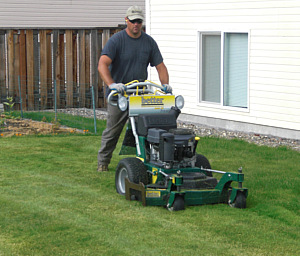
Don’t bag the clippings! Leave them on your lawn to decompose naturally. Grass clippings decompose quickly and are a source of nutrients and organic matter. Did you know that about 25% of the nitrogen in your lawn fertilizer is removed with grass clippings?
Grasscycling is the easiest way I Know to reduce fertilizer inputs and grow an eco-friendly lawn.
Mowing Tip #5 – Protect Our Rivers and Lakes: Cleanup Clippings
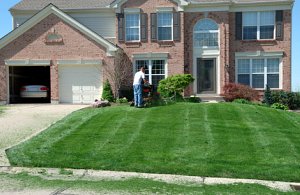
Keep grass clippings on the lawn and out of streets, driveways and sidewalks. Sweep or blow them back into your yard. Grass clippings are full of nutrients – they are basically fertilizer – and when left on sidewalks, driveways or on the road they will wash into storm drains and find their way into our rivers and lakes.
Debris from yard waste that ends up in our waters is a bigger source of phosphorus water pollution than lawn fertilizers.
Mowing Tip #6 – Lawn Striping: Cut Grass Like a Pro
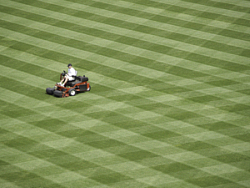
Have you ever wondered how the professionals mow the cool designs and patterns on the baseball fields? Or the alternating stripes on football fields and golf courses?
Striping is a simple lawn mowing technique that leaves your yard looking professionally manicured.
Click Here to learn how to stripe your lawn like a pro
More Essential Lawn Care Practices
How to choose the best lawn fertilizer. What do the numbers on the bag mean? Are organic fertilizers more eco-friendly than chemicals? Consider costs and nutrient needs. Are they pet-safe?
Use this fertilizer calculator to determine the amount of granular fertilizer product that is needed to spread on your lawn according to recommended rates.
Overseeding lawns to repair and maintain a thick, healthy lawn
Benefits of overseeding lawns in the fall. Lawn repair after summer stress keeps them healthy, thick and weed-free. Helpful DIY lawn care tips and advice for planting and growing grass.
